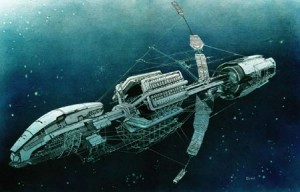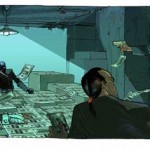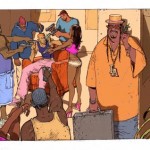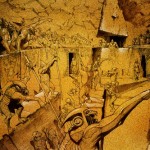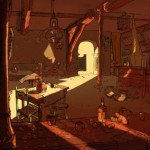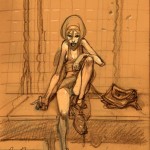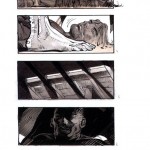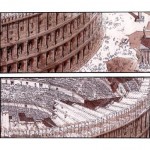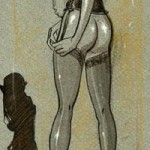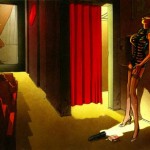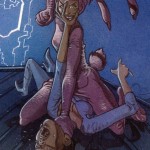Sylvain Despretz
CG Elite Archive Interview
His career began almost two decades ago now. He has worked with some of the most celebrated film directors in the world. But before getting there, this artist began as an illustrator, worked for the commercial world before moving up to film. You have probably seen his work into such blockbuster films as Alien Resurection, Black Hawk Down, The Fifth Element and many more. He has seen the emergence of digital art but still believes artists today rely too much on technology. He also believes most digital artists today are naive about Hollywood and the industry we live in. Read what this experienced artist has to say about it all.
Introducing Sylvain Despretz.
CGC: Could you begin by telling us about your professional career, how it all began and how you got to where you are today?
Sylvain: My first gig as an illustrator consisted of freelancing spot illustrations for local News Magazines in Rochester, upstate New York, where I went to school. I did not study Art, particularly, by the way, but rather a broad Academics curriculum, with an accent on Anthropology. I also spent a couple of summers taking pictures at Rock Shows, and Interviewing Musicians, for local College Newspapers…Musicians like Peter Gabriel…
On some level, you might say that it does not relate to my career in film, but on another level, it did teach me that everybody, famous or not, is accessible.
Furthermore, I learned to photograph in Low Light conditions, and much later, this also ended up relating to dealing with notions of Light and Shadows in Motion Pictures; directors like Ridley Scott, for instance, are very responsive to artists who understand subtle effects created by deep shadows, and complex compositions that utilize obscurity and silhouettes…
My “Rock & Roll Journalist” days did give me a good primer.
On that note, it’s worth mentioning that Arthur Max, Ridley’s production designer was “lighting designer” for the 70’s art rock group Pink Floyd – here’s that Rock connection again…
My first proper job was in Neal Adam’s Art Studio in New York City: Continuity Graphics. There, I learned the relationship between agents, artists, art buyers, and deadlines. I also learned that people often try and rob you blind; I quickly developed a very defensive attitude in business, borderline aggressive.
The place was a sweatshop, and I left there after a year, and ended up working for big advertising agencies.
During my stay at BBDO, a large New York advertising group, I ran into Ridley Scott. Soon after that, I was encouraged to move to Los Angeles, and things changed very rapidly from that point on.
Several directors whom at the time were only known as Commercial directors offered to bring me onto their first feature film. One such director was David Fincher. I worked in Hollywood, and London, primarily on unremarkable pictures (Universal Soldier, The Fifth Element, the Avengers ), and looking back, I’d say that I did not really begin to have career credibility until I became involved with a Ridley Scott film…The first significant project for me was something called “I AM LEGEND”. The picture did not get made, but the Press surrounding the development phase was tremendous, then, GLADIATOR followed.
You could say that most people are essentially interested in the Prestige of the movies that I worked on, more so than any objective notions of personal artistry, or drawings, but I guess you can’t ask too much of people.
Basically, the most important ingredient was always time; things always took much longer to evolve than I would have liked, but eventually, I know I always get to my objectives.
CGC: What was the first film project you were first involved with?
Sylvain: When I was still a University Student, I was offered a spot in the art department of a low budget picture called FEAR NO EVIL ( Frank LaLoggia – director ).
The picture was awful, but I did meet a Creative Consultant, Raul Da Silva, who has since become an instrumental guide throughout my career, as well as a good friend.
The second film I worked on was called THE IN CROWD ( Mark Rosenthal – director ), and it also turned out to be a Box Office disaster, but again, it was in many ways a valuable training ground…Back then, I had no idea what I was doing, but it didn’t matter much because evidently, no one else did either.
Those small films were a window into the quirky and slimy dealings that take place between miserable people who make films on that level. I learned a lot, humanly, if not technically. Strangely, though, again, the first AD ( Director’s Assistant ) on that film, Fred Baron, is now a Top Brass Producer at FOX, and the only reason I know him today is because “we go far back”, as he puts it…Nothing’s ever wasted.
CGC: You had been dreaming of working in the film industry pretty much since the beginning of your career. How does reality compare with your initial perception?
Sylvain: Perceptive question; things often surprise us, when we get to them. I had, in fact, been dreaming of working in film since Childhood.
I was especially lucky because I ended up working for the very people who inspired me when I was still a young man…My drawings have been seen by Ridley Scott, Stanley Kubrick, I got to meet real personal heroes like John Schlesinger, Sidney Lumet, etc…For me, the reality is close to what I imagined, but one thing seems very different: The Audiences have mutated.
Today, more than ever, working in movies, means addressing a crowd who is terribly young and immature…In a way, it has forced movies to be “numb-skulled”; more so then when I began…
I wish there were still a way to make something as profound as 2001, a Space Odyssey, in today’s market, but I’m afraid that sort of extreme blend of brilliance and money can no longer meet on the Silver Screen. I personally heard the very directors I just mentioned lament about this as well, which signals that this isn’t simply a case of my being disillusioned, but rather an objective change that has taken place. It has its roots in the economy of how films are financed.
CGC: What valuable lessons have you learned in the process?
Sylvain: Many.
I have learned that Professionalism is often antithetical to Enthusiasm, but that when given a choice, it is also more reliable.
I have learned that whenever ANYONE asks you what you think of the script, the ONLY proper response is that you “love it”.
I have learned that it is best to keep your cards close to the vest: People aren’t really interested in hearing about your “real” dreams, when they are perfectly happy to use you where you are.
I have learned that the job that pays the best is also the one that gives you the least amount of grief.
I have learned NOT to work with the French, who are, by far, the least professional ensemble out there.
I have learned that Directors are fond of us, somewhat, but Production Designers often feel threatened by us, and would love to make us go away.
I have learned that the front gate of a Movie Studio resembles the Drawbridge of a Feudal Castle during the Height of the Monarchy, and that it’s just the beginning of the analogy…
CGC: What aspects of a project are important to you?
Sylvain: Truthfully:
Money is important. Most people look down at an artist who puts money at the top of his list, but I really did not learn to draw so I could spend my life letting other people tell me what to draw. The fact that I do it, and that I lend my time to an Industry which isn’t primarily about Drawings, is only justified by the fact that people agree to give me money.
Image above: Eyes Wide Shut
I am a sort of Artistic Rent-A-Friend; “rent” being the operative word.
Of course, working with people you admire is important, and trusting them, and being able to learn from them, is also important…But for me, anything can be pleasant, if the working conditions are made pleasant.
– Are you paid properly for your time, and for the inconvenience of living far away from your loved ones?
– Will you have to fly for thirteen hours in the crammed seat of the coach section of a cheap airline?
– Have you been booked in a Squalid Hotel, while the Producer’s mistress is hemorrhaging thousands of Production Dollars?
When you have worked in the business long enough to notice the many ways people abuse your good disposition, you begin to pay less and less attention to the content of their script, and more and more to the content of their character.
Lately, I have chosen projects in terms of traveling opportunities; if a production offers to bring me to Rome, I will go along, because going to an exotic place can be as important, or more, as the project itself.
Besides, in Rome, I can stock up on Coffee from Sant’ Eustachio’s – the best in the World!
Ultimately, a project that belongs to somebody else, no matter how “hip” it may seem, is not something that I am going to want to give more personal involvement than a project that may someday belong to me. I do a great job, to the extent that I am a professional, but my heart is not for sale.
Artists can be naïve about all this, and wrongly focus only on the artistic components of a job.
When artists are uninterested in the inner workings of Hollywood, they tend to get taken, and taken, and bled, until they have nothing more to give.
Then, Burnout sets in, and they can get dropped like an old shoe.
CGC: Why is it important that new, younger artists get to understand how our industry, how Hollywood works?
Sylvain: Well, partially because most artists are so oblivious to the business aspect of how films are made that someone who takes the time to learn has an instant head start on the pack.
Let’s not be shy about it: Artists are all about competition…How to grab the job from under another artist’s feet…
One way to be ahead is to understand Producers, because they are the ones doing the hiring, and in movie terms, they are the ones with a problem to solve. You can be alternatively “the problem” or “the solution”, but you first have to understand what they are dealing with. If you become a “producer friendly” artist, you will be instantly noticed, and you can coast for quite a while.
As it stands, white collar authority figures look at artists like a Duchess looks at a Bedbug. Artists are not respected, within the context of a business enterprise that depends on them more and more. The bigger the Video Games, the Movies, the Theme Parks, the more artists are allowing themselves to be reduced to cheap commodities. Now, the apparently dazzling introduction of Computer Art is moving our profession one step closer to expandability…
Artists do not see it, but they are being played against each other, and they are falling off the cliff like Lemmings into the water.
CGC: You believe artists these days are becoming slaves to technology?… Could you elaborate?
Sylvain: Computer Artistry is the Pied Piper of today’s market…It is stunning, seductive, and it is allowing a whole generation of artists to be entirely dependant on its sophisticated software. I know people who are successful artists, but who are totally crippled without Photoshop, Maya, or Painter…They can’t survive a Job with just a Pencil in hand…They only have to pray that the current Look is not a passing fad, and that everything they are learning to do in order to distinguish themselves will not be rendered obsolete, like the airbrush – the Yardstick of 1970’s commercial artistry – which was dumped almost overnight…
Don’t get me wrong, I am not against digital technology…I am merely saying it is a tool for the Men, not the Boys…
People, as always, should learn to walk before they can run…Artists should practice their chops, and remember that drawing is what entitles them to a career that is life-long…Not Bill Gates, and not Steve Jobs…Those guys are Technology peddlers, and they aren’t interested in what’s left in the field after the Locusts have gone.
For my part, I use a computer, but only to implement my approach to drawing…and I take a certain amount of pride in using the computer to basically replicate what I would do with paint…
I love it when someone asks me if I used Gouache or Acrylic, and I answer: It’s Digital!
I know, if I can fool them, then the machine is a tool, and I am not a tool to the machine.
CGC: It is normally assumed that technology helps artists free themselves from the technical limitations of traditional media. You disagree with that assumption. Why?
Sylvain: Any idea is correct until you take it too far. Traditional Media is also a form of technology…Several centuries ago, artists had to mix their own paint; today, we feel that our ability to go to a store and buy a tube of Ultramarine is a sign of progress, but I know people who would argue that one should be able to mix their own colors from pigment…
I am not an extremist, but I know that Artistry and Illustration demand years of intense discipline…Mastering the human figure, mastering perspective, mastering color, and ultimately developing good taste, are not “givens”…Those qualities are the result of an immense process of humanization and growth.
From an artist’s point of view, you either are lucky enough to have been taught that, or you are not. Technology either focuses your skill, or disperses it.
If you look at the history of Art and Music over the last hundred years, you’ll see that with the best of seeming intensions, standards have been gradually simplified then, totally eroded, down to a point where simplicity and accessibility seem to have become the primary focus…
Complex Artistic Skills were deemed elitist, so Great Illustrators were cast out into Ghettos, while Pop-Art Mongers invaded mainstream culture and dinner parties. Bored Rich Teenagers started pouring in and out of Art Schools, because the prior “screening process” of apprenticeship left no room for Self-Deception.
In music, after enjoying a Century of rich and heartfelt compositions in Contemporary Classical, Jazz, Big Band, Blues, Rock & Roll, all disciplines requiring a decent amount of Skillfulness, we are asked to accept Star-Puppets barking to walls of prerecorded sounds…They even have a new name for “ripping-off without crediting”: it’s now called “Sampling”.
On television, airwaves a filled with shows where people are being celebrated for being ordinary and having nothing special whatsoever…
Do you see a pattern here?
The Artist in me doesn’t want some moron-child, raised on GTA or DOOM since age 3, telling me what is good, and what is not, but we are coming to that.
CGC: Why is it important that digital artists also master traditional media?
Sylvain:
Why is it important that an Airline Pilot master Flight without instruments? Why should we continue to walk and use our legs? Why is it important to keep matches and candles around the house?
Someday, someone will switch the power off, that day may be closer than we think…
If your Artistic Identity has been woven into the fabric of MAC or PC, then you have to recognize that you are that kind of artist…Your ass belongs to “them” already.
The only crime here is to do things without the knowledge that we’re doing them, and I fear that “artistic children” of today are dancing merrily, unaware of where the Piper is taking them…or where they will be when he stops playing…
Recommended Links by artist:
FAQ on “How to start a career as a Hollywood Artist“
Recommended book by artist:
Special Effects: An Oral History-Interviews with 37 Masters Spanning 100 Years

